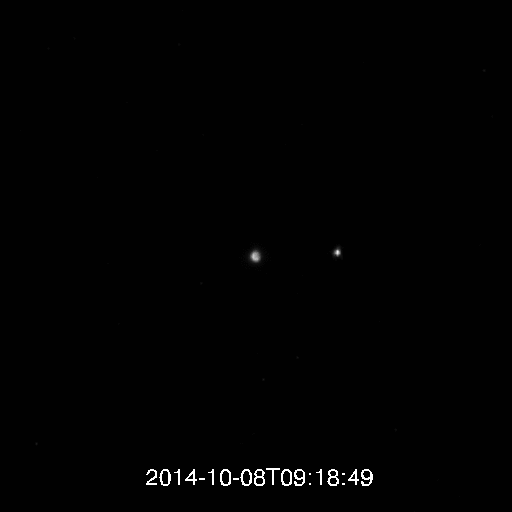Acquaintance and farewell to Mercury

It seems strange that the third closest planet to Earth, until recently, has been the least studied. More than a dozen spacecraft flew to Venus and Mars. Even Jupiter had earthly messengers more often. Saturn has had a powerful Cassini research station for the second decade. It seems that a conspiracy has developed against Mercury.
Unfortunately, there is no conspiracy here. More precisely, there is, but this is a conspiracy of the forces of nature. Mercury is very close to the Sun, so not all telescopes can observe it. For example, the Hubble Space Telescope cannot shoot because of the danger of exposure. It is more difficult for spacecraft to get to Mercury than to Jupiter or even Pluto. Flying into the outer solar system is relatively simple - just pick up a third cosmic speed: 16.65 km / s. Fly to Mercury is also simple - starting from Earth, you need to slow down.
Difficulties begin when the satellite tries to linger at Mercury and enter its orbit. The first planet of the solar system - also the smallest - its mass is negligible compared to the colossal attractive force of the nearby Sun. Those. starting from Earth towards Mercury, we will actually fall on the Sun. To delay the fall and enter the orbit of Mercury, it will take a lot of fuel.
Due to such difficulties, NASA's first Mercury artificial satellite orbited in orbit around the sun, just flying past the planet. “Mariner-10” only three times in 1974 and 1975, whizzed past Mercury, having managed to remove less than half of the visible surface.

This picture is practically the only thing that scientists had to study the surface of the planet. There were still some results of ground-based observations, for example from radio telescopes, but they were clearly not enough for a detailed idea of the planet.
Therefore, in the 80s they conceived a new expedition. To do this, it was necessary to calculate a new trajectory in which the spacecraft actively used the gravity of nearby planets. The new NASA Messenger spacecraft, launched already in 2004, used a completely insane trajectory, which included two flights from the Earth, two flights from Venus, and three flights from Mercury, and only at the fourth meeting did the planet enter orbit. Such a route required a lot of time, but saved fuel, which means the mass and cost of the entire expedition.
Having flown almost 8 billion km (the distance to Pluto at its maximum distance), Messenger once again approached Mercury and entered an elliptical orbit. He approached the surface for 200 km, and then retreated to 15 thousand km. Such an orbit was required for several reasons. First of all, there were technical limitations: the device could overheat from solar radiation reflected from the surface of Mercury. Messenger was hiding from direct sunlight by a composite shield, but the surface of the planet reflects about 8% of solar radiation, which is also quite a lot in those places. In addition, the elliptical orbit made it possible to shoot and study Mercury with different image capture latitudes, from narrow high-resolution frames near the surface to wide ones from far away.

Scientific instruments of the spacecraft made it possible to carry out a wide range of planetological studies: visible and near infrared cameras made it possible to examine and map the planet, sets of multispectral filters to evaluate color variations of the soil; neutron, gamma and x-ray spectrometers helped to determine the elemental composition of the surface and the water content in the surface layer; The laser altimeter created a map of the heights of Mercury, and helped to “look” into the eternally dark craters at the poles of the planet. Several instruments helped to study the external conditions in which the satellite had to work and constantly stay on the planet: a magnetometer was able to determine the magnetic field of Mercury; ultraviolet spectrometer - to study the rarefied atmosphere and exosphere,

This is actually a “gentleman's set” of instruments that are required for the initial study of solid cosmic bodies in the solar system. It is suitable for planets, and for comets, and for asteroids.
And what did you manage to do in four years?
At first, no one imagined that the device would last so much. Initially, work was planned for a year. Then extended for a year. Then again ... As a result, the device was kept in orbit until the last - while it allowed a supply of fuel.
The first thing the planet mapped. The dream of many astronomers and planetologists came true - they were able to look into the darkness.

However, darkness still remained in the craters of eternal night at the poles of the planet. The axis of rotation of Mercury is practically not deflected and perpendicular to the plane of the orbit; therefore, the Sun never looks into deep craters at the poles of Mercury.
The first intrigue is associated with these shady areas. Radio astronomical observations of the planet back in the 90s revealed interesting details - at the poles found areas that reflected radio waves almost exactly like water ice should have done. Ice? On a planet where the temperature at the equator reaches +350 degrees Celsius during the day? Seriously?

So they did not believe radio astronomers until Messenger arrived. The first discovery he made was to determine that the areas “shiny” in the radio range exactly correspond to the areas of eternal shadow in the polar craters. To study their contents, a laser rangefinder was used. Of course, its intensity would not be enough for backlighting and direct shooting with cameras. But the range finder allows you to determine the intensity of the reflected laser beam. And the first attempts to shine a laser into the glaciers gave a discouraging result - the alleged ice was about two times darker than the soil surrounding the craters.

A neutron spectrometer helped here - he was able to determine that there is still water in the polar regions, i.e. data from this device also turned out to be in favor of ice. Although its resolving power did not allow to precisely tie shaded craters to an increased concentration of water in the soil.

In the diagram, red is a high degree of neutron deceleration, i.e. sign of hydrogen in the soil.
Finally, the laser rangefinder caught a sparkle - in the most subpolar and deepest craters, the surface reflected light four times as much as the surrounding soil did - further evidence of the presence of ice was obtained. But what about black-black craters? In order to understand what was going on in the dark, we had to develop a new thermal model of the surface. It turned out that in the craters, where the sun peeks at least a little, the reflection of light from the walls of the crater still falls to the bottom. Thanks to this, I was able to look into the darkness at a long shutter speed.

And this is precisely what explained why we did not see ice at the bottom - even the weak light reflected by the walls of the crater is still able to melt the ice lying on the bottom. And in order to understand what we are seeing then, we need to remember where the ice may come from on Mercury.
The main source of ice and water in the inner solar system are comets. Although the Rosetta study questioned the comet origin of the Earth’s oceans, and the LRO study, including the Russian LEND instrument, questioned the comet origin of the water on the Moon, one can speak with confidence more confidently. In its vicinity, comets appear much more often, because The sun pulls them with its gravity, like flies to honey.
Therefore, comets are much more likely to fall on Mercury than on any other body in the solar system, with the exception of, of course, the Sun.
As many remember, a comet is a “dirty snowball” - a piece of ice with dust and carbon compounds, similar in texture to coal. This is where scientists got to the answer to the mystery of dark craters - organic matter . The ice brought by the comets rests at the bottom of the knocked out craters, covered with a thin dark layer of organic compounds ... Water and organic compounds are seemingly the best ingredients for the origin of life, but there is still not enough atmosphere to maintain water in a liquid state, therefore, like on comets, on Mercury, inhabitants are not expected.
But Mercurian puzzles do not end there. Messenger considered another feature of the planet’s surface, which they could not completely explain.

Strange sections of jagged soil, which were called “hollows”, are found almost throughout Mercury. So far, scientists can only say that the depressions are of recent origin, so much so that perhaps the process of their formation continues to this day. This was determined by the presence of meteorite craters. More precisely, by their absence, which indicates the comparative youth of the formations.
The depressions expose the underlying soil of bluish or bluish color.

The hollows have some kind of attachment to the outcrops of volcanic lava, but these volcanoes calmed down long before the hollows began to form.

It is believed that this is a kind of volatile mineral that slowly evaporates under the influence of sunlight or even charged particles, but Messenger devices did not allow to accurately determine the composition and characteristics of the changing soil.
Other, less intriguing but curious discoveries on Mercury were the magnetic field and signs of recent volcanism.
The magnetic field is one hundred times weaker than the earth, but even such an intensity indicates the liquid core of the planet and the ongoing currents in it.

Relatively recently calmed volcanoes also came as a surprise. Perhaps even dinosaurs could observe eruptions on Mercury, if they had the appropriate technology.

Messenger made a unique observation in the history of space exploration by looking at the Earth / Moon system. He was able to see and show us the lunar eclipse.

This is not transit when one cosmic body overlaps the line of sight of another body, but an eclipse when one body is hiding in the shadow of another body.
The spacecraft has been operating in the orbit of Mercury for more than four years. Initially, so much was not planned, but the equipment and devices worked well, so the engineers tried to keep Messenger in orbit longer, and the project managers wanted to get the funding for next year. Every year, the satellite’s orbit decreased, but scientists used this to obtain higher resolution images, and a more thorough examination of the terrain.
By the end of 2014, the device had completely exhausted its fuel reserves, but it was possible to extend the operating time by several months by providing a reactive impulse with compressed helium, which was used to create pressure in the fuel tanks.
Finally, it's time to say goodbye to the spacecraft. On April 30, with the “last breath” of the propulsion system, the satellite was directed to the place of its eternal calm.

A few hours before the impact on the surface, Messenger managed to remove Mercury from an altitude of about 50 km.

On this his story ended. But science did not end. Scientists have yet to process a lot of data, and the result will be more discoveries. Moreover, now Mercury will again be left alone with itself and comets for almost 10 years. The next European-Japanese device BepiColombo is going to be launched in 2017, and it will arrive only in 2024. Russia also takes part in the project - Roscosmos gives the Soyuz rocket and the Frigate upper stage.

BepiColombo is expected to be able to solve the puzzles left by Messenger.
